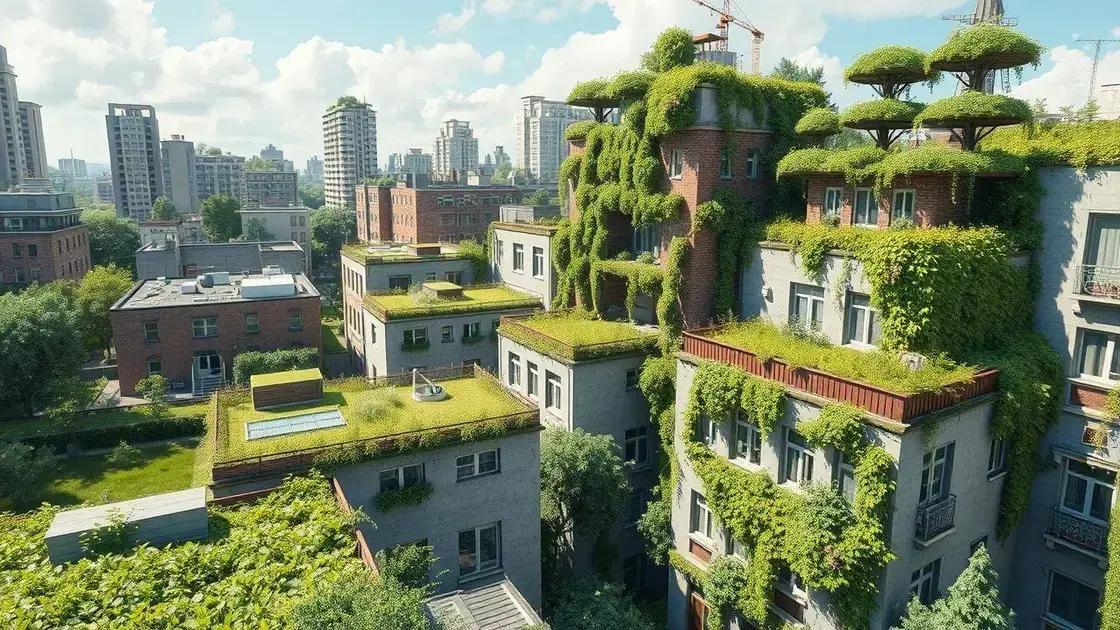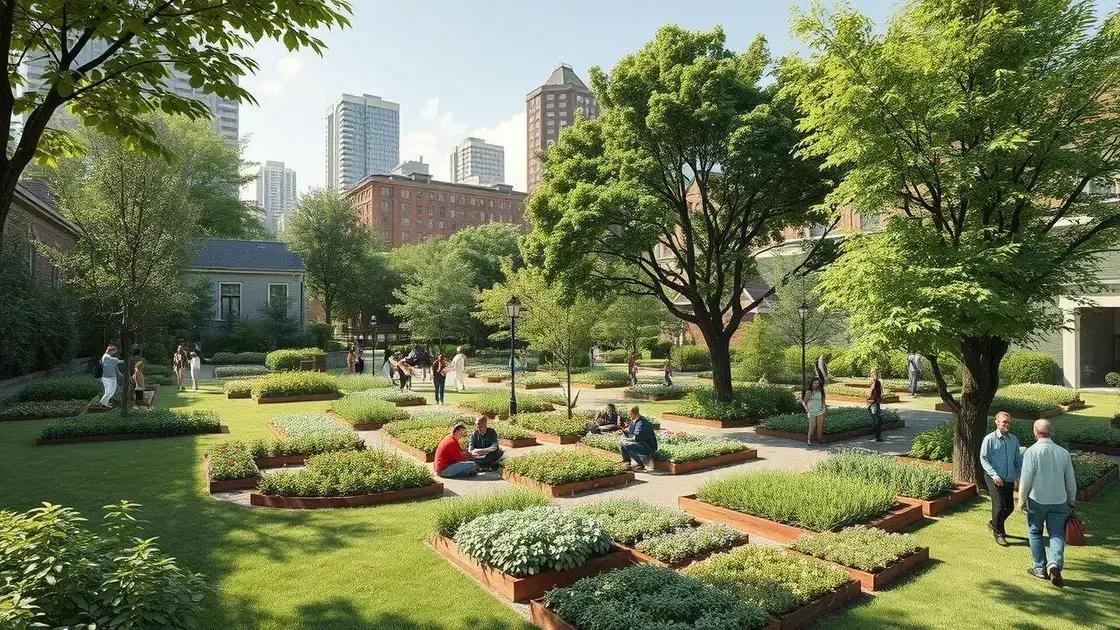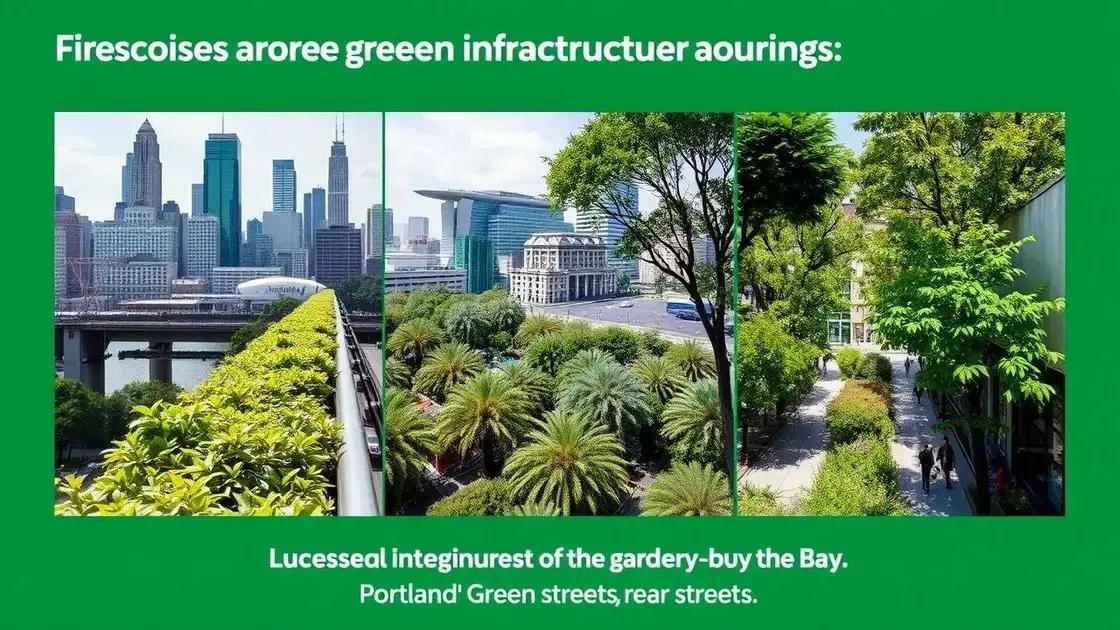Insights on green infrastructure headlines: uncovering trends

Green infrastructure integrates natural systems in urban areas to manage stormwater, improve air quality, and enhance community well-being, as demonstrated by successful projects like New York City’s High Line and Singapore’s Gardens by the Bay.
Insights on green infrastructure headlines reveal how our cities are evolving with nature. Have you ever wondered how intelligent design impacts the way we live and interact with our environment? Let’s dive deeper into its significance.
Understanding green infrastructure
Understanding green infrastructure is key to creating resilient and sustainable urban environments. It refers to a network of natural and semi-natural systems that are integrated into urban settings. These systems contribute to ecological functions, improve the quality of life for residents, and enhance urban resilience against climate change.
What Is Green Infrastructure?
Green infrastructure encompasses various elements, including parks, green roofs, rain gardens, and urban forests. These features help manage rainfall, reduce flooding, and improve air quality. By utilizing natural processes, cities can adapt to environmental challenges.
Benefits of Green Infrastructure
Integrating green infrastructure has multiple advantages:
- Improves air and water quality
- Enhances biodiversity in urban areas
- Reduces the heat island effect
- Increases recreational spaces for communities
Each of these benefits contributes to healthier living conditions and a more sustainable future. By reducing the reliance on traditional infrastructure, cities can invest in a greener transformation.
Moreover, local communities often feel a stronger connection to their environment when they see nature woven into the urban landscape. Parks and green spaces foster social interaction, promote well-being, and serve as venues for outdoor activities. The positive impacts extend beyond aesthetics—they can improve mental health and provide educational opportunities about the environment.
Innovations in Green Infrastructure
Currently, many cities are adopting innovative approaches to incorporate green infrastructure.
- Using permeable materials for roads and pavements
- Implementing green walls on buildings
- Creating wetlands for natural water filtration
- Developing community gardens for local food production
These strategies illustrate a shift towards more sustainable urban planning. They not only adapt to environmental conditions but also empower communities to take part in shaping their surroundings. By prioritizing green infrastructure, cities can pave the way for a resilient future that values both nature and urban development.
Benefits of green infrastructure for urban areas

The benefits of green infrastructure for urban areas are extensive, playing a crucial role in enhancing both the environment and community well-being. By bringing nature into city landscapes, we create healthier living spaces and promote a sustainable way of life.
Environmental Benefits
One of the major advantages of green infrastructure is its positive impact on the environment. These features help manage stormwater, reducing the risk of flooding and pollution in waterways. Green roofs and permeable pavements allow rainwater to soak into the ground, minimizing runoff.
- Reducing urban heat island effect
- Improving air quality through natural filtration
- Enhancing biodiversity with natural habitats
- Supporting healthier ecosystems
Incorporating such systems into urban planning can significantly improve local climate resilience.
Social Benefits
Green infrastructure also offers social benefits by improving the quality of life for residents. Access to parks and green spaces encourages outdoor activities and community engagement. Research shows that people living near green areas tend to have better mental health and less stress.
Enhancing community ties is another positive effect. Green spaces often serve as meeting points for neighbors and foster interactions among residents. They can also provide safe areas for children to play and families to spend time.
Economic Benefits
From an economic standpoint, green infrastructure can add significant value to properties. Homes near parks or nature trails often see higher property values and increased demand. Moreover, investing in green solutions can lead to lower infrastructure maintenance costs in the long term.
- Attracting tourism and local businesses
- Reducing energy costs through natural cooling
- Creating job opportunities in green projects
- Promoting eco-friendly practices in the community
Thus, the economic rationale for green infrastructure is compelling, showcasing the long-term savings and growth it can foster in urban areas.
Innovative solutions in green infrastructure
Innovative solutions in green infrastructure are transforming how urban environments manage natural resources and respond to climate challenges. These solutions offer creative ways to integrate nature into the built environment, improving both sustainability and livability.
Smart Water Management
One groundbreaking approach focuses on smart water management systems. Techniques like rainwater harvesting and bioretention systems can reduce stormwater runoff. These solutions are designed to capture, store, and reuse rainwater, helping cities mitigate flooding.
- Rain gardens that filter and absorb rainwater
- Permeable pavements that allow water to permeate
- Retention basins for storing excess rainwater
- Green roofs that absorb rain and provide insulation
Such strategies not only help manage water effectively but also enhance urban aesthetics.
Vertical Gardens and Green Walls
Another exciting development is the use of vertical gardens and green walls in urban infrastructure. These installations bring nature to building facades, making cities greener. They improve air quality and provide insulation.
Green walls can also help reduce the urban heat island effect, cooling down cities during hot months. Adding greenery to city buildings creates a more inviting atmosphere and contributes to biodiversity.
Community Engagement in Design
Innovative solutions often involve the community in their design and implementation. Participatory design encourages residents to share ideas on green spaces. This engagement empowers communities to take ownership and pride in their local environment.
- Workshops that brainstorm ideas for new green spaces
- Community gardens that involve local residents
- Monitoring programs that track the success of green initiatives
- Local art incorporated into green spaces for a unique identity
Overall, these collaborations foster a sense of belonging and improve the quality of urban life.
Case studies of successful green infrastructure projects

Exploring case studies of successful green infrastructure projects reveals valuable insights into how cities can effectively integrate nature into urban planning. These real-world examples demonstrate the positive outcomes of sustainable practices and innovative solutions.
New York City’s High Line
The High Line is a prime example of transforming an abandoned railway into a vibrant green space. This elevated park features gardens, walking paths, and community art installations. Since its opening, it has revitalized the surrounding neighborhood, attracting tourists and boosting local businesses.
- Increased property values in the area
- Enhanced biodiversity with native plant species
- Provided a community space for recreation and cultural events
- Served as a model for other cities seeking to repurpose unused land
This project highlights how green infrastructure can enhance urban life and encourage economic growth.
Singapore’s Gardens by the Bay
Another notable case is Singapore’s Gardens by the Bay. This project combines advanced technology with lush landscaping. The iconic Supertree Grove and climate-controlled domes promote biodiversity while providing a stunning urban garden. The project effectively manages rainwater and reduces heat through natural methods.
These remarkable gardens draw visitors from around the world. They showcase how cities can embrace nature and technology to create beautiful, functional spaces.
Portland’s Green Streets
Portland has made great strides in incorporating green infrastructure through its Green Streets program. This initiative uses bioretention planters and permeable pavements to manage stormwater runoff.
- Improved water quality in local streams
- Reduced flooding incidents after heavy rains
- Enhanced neighborhood aesthetics with greenery
- Engaged communities in sustainable practices
Portland’s commitment to green infrastructure illustrates the effectiveness of integrating ecological solutions into urban systems.
FAQ – Frequently Asked Questions about Green Infrastructure
What is green infrastructure?
Green infrastructure refers to a network of natural and semi-natural systems integrated into urban environments to manage stormwater, improve air quality, and enhance overall urban livability.
How does green infrastructure benefit urban areas?
It provides multiple benefits, including improved air and water quality, increased biodiversity, enhanced property values, and reduced urban heat, all contributing to healthier communities.
Can you give an example of a successful green infrastructure project?
Yes! The High Line in New York City is a successful example, transforming an abandoned railway into a vibrant park that revitalizes the neighborhood and attracts visitors.
How can communities get involved in green infrastructure projects?
Communities can engage through participatory design sessions, volunteer for local green space projects, and provide feedback on planning initiatives to ensure their needs are met.





